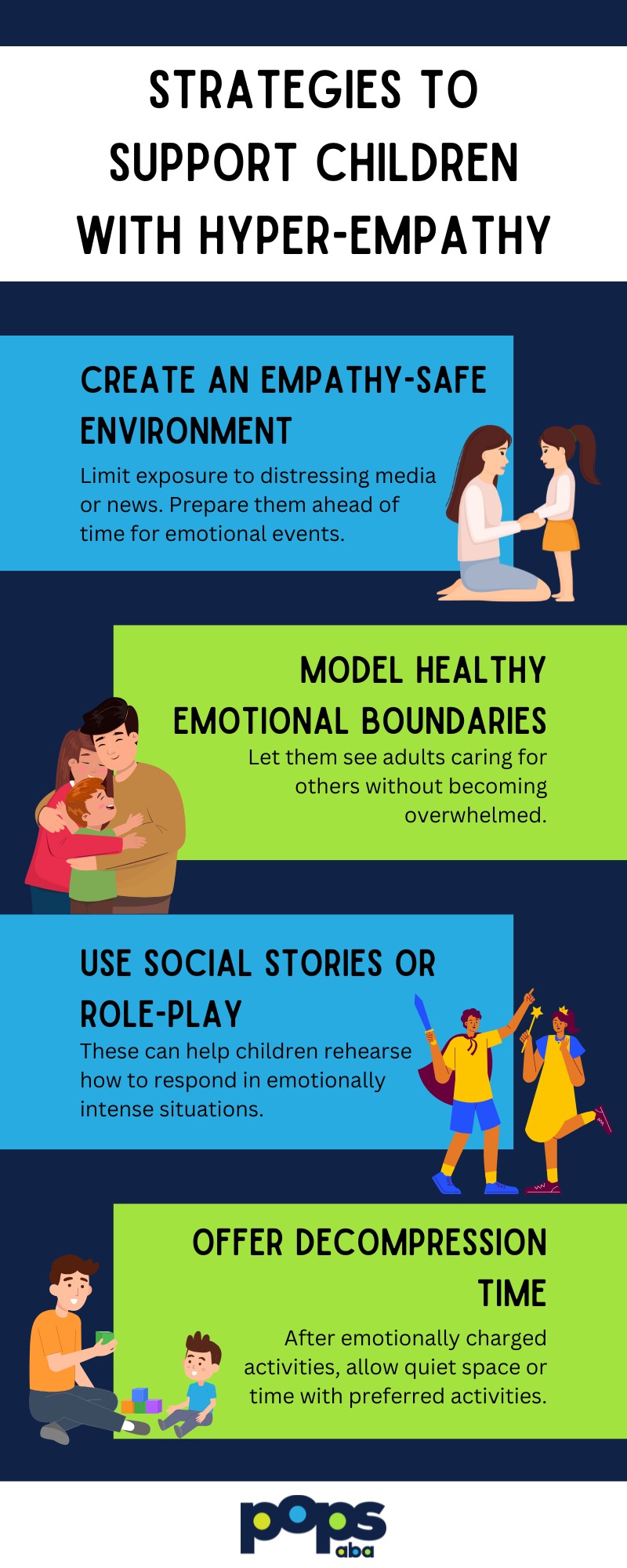Key Points:
- Hyper-empathy in autism symptoms may include emotional overload, mirroring distress, and difficulty separating others’ emotions from their own.
- While empathy in autism is often misunderstood, some individuals experience heightened sensitivity to others’ feelings.
- Managing hyper-empathy requires emotional regulation strategies, tailored support, and caregiver awareness of triggering situations.
While autism spectrum disorder (ASD) is often misunderstood as involving a lack of empathy, this isn’t always the case. In fact, some individuals—especially children—experience hyper-empathy, which is a heightened sensitivity to others’ emotions and experiences.
Understanding hyper-empathy in autism symptoms is crucial for parents, educators, and caregivers aiming to offer supportive environments. These symptoms can significantly affect daily interactions, social connections, and even self-regulation, making it essential to recognize and accommodate them early on.
What is Hyper-Empathy in Autism?
Hyper-empathy in autism includes intense emotional mirroring, emotional overload, and trouble distinguishing others’ feelings from one’s own. Children may cry when others cry, feel physical distress watching emotional scenes, or become overwhelmed by others’ moods.
This form of emotional hypersensitivity can lead to behavioral outbursts, avoidance of emotional situations, or shutting down. Hyper-empathy may not be present in all autistic individuals, but for those who experience it, the emotional intensity can be overwhelming and affect learning, relationships, and day-to-day life.
Is Hyper-Empathy Common in Autism?
Hyper-empathy is not universal in autism, but it occurs more often than many people assume. While some autistic individuals have challenges interpreting others’ emotional cues (cognitive empathy), many show strong affective empathy—feeling others’ emotions deeply, sometimes more than expected.
This disparity has led to myths about autistic people lacking empathy, when in fact, they may just experience empathy differently or more intensely. Children with hyper-empathy often face unique challenges: they might not be able to verbalize why they feel upset, may withdraw from group settings, or may mimic others’ distress. These reactions can be misinterpreted as behavioral issues rather than signs of emotional overload.
What Does Hyper-Empathy Look Like in Children with Autism?
Children who display hyper-empathy often show distinct behavioral patterns. Recognizing these patterns can help parents and educators intervene constructively. Below are some typical manifestations of hyper-empathy:
- Crying when others are upset, even if the child is not directly affected by the situation.
- Mirroring pain or discomfort, such as flinching or expressing distress when others are injured.
- Absorbing the mood of the room, becoming anxious or sad without understanding why.
- Avoiding emotionally charged media, such as sad movies or news stories, due to strong reactions.
- Attempting to comfort others compulsively, even in situations where they don’t understand the context.
These children may become emotionally exhausted after social situations or need recovery time after empathic overload. When not understood, their reactions might be mislabeled as oversensitivity or attention-seeking, when in reality, they stem from genuine emotional resonance.
Why Is Hyper-Empathy Overlooked in Autism?
Hyper-empathy in autism is often missed because it contradicts outdated stereotypes. Autism has long been associated with a “lack of empathy,” which is both misleading and incomplete. While some individuals on the spectrum do struggle with social cognition (the ability to read social cues), that does not equate to being emotionally disconnected.
In fact, many autistic individuals report experiencing too much empathy—feeling overwhelmed by others’ suffering or deeply moved by emotional content. This internal experience may be hidden behind outward behaviors like shutting down, crying, or trying to escape emotional triggers. Without proper context, caregivers might interpret these actions as disinterest or defiance.

How Can Parents Recognize Signs of Hyper-Empathy?
Parents are usually the first to spot emotional sensitivities in their children, but hyper-empathy can manifest in subtle or confusing ways. Look for patterns that suggest emotional overload or heightened reactivity to others’ emotions.
Here are some common signs:
Overwhelming Emotional Responses
Your child may cry, panic, or shut down when witnessing someone else’s pain, even in mild situations.
Avoidance of Emotionally Charged Environments
They might steer clear of places like hospitals, funerals, or movies with intense emotional content.
Highly Attuned Emotional Support
They show unusual levels of concern or caregiving behavior, often trying to fix or absorb others’ distress.
Emotional Confusion
They may struggle to separate their own emotions from others’, feeling anxious without understanding why.
Mood Matching
Their mood rapidly shifts to mirror the emotions of people around them, even without direct interaction.
Physical Symptoms
They might experience headaches, stomachaches, or fatigue after emotionally intense situations involving others.
If your child shows several of these behaviors consistently, it may be worth exploring emotional regulation strategies tailored to children with autism and hyper-empathy.
How Can Hyper-Empathy Affect Daily Life?
Hyper-empathy can be both a strength and a challenge. On one hand, children who deeply feel for others often form strong connections and demonstrate compassion. On the other hand, unfiltered emotional absorption can disrupt daily functioning.
In school, hyper-empathy might lead to:
- Trouble focusing when peers are upset.
- Withdrawal from group work due to emotional overload.
- Challenges with conflict resolution due to heightened emotional stakes.
At home, it might cause:
- Over-involvement in family emotions (e.g., becoming upset when parents argue).
- Difficulty sleeping after emotional events.
- Burnout after social gatherings.
These children need predictable routines, downtime to decompress, and guidance to understand and name their emotions. Helping them develop boundaries—such as “It’s okay to care, but it’s also okay to step away”—can build emotional resilience.
Strategies to Support Children with Hyper-Empathy
Helping a child with hyper-empathy involves teaching them to recognize emotions, set boundaries, and develop coping tools. Emotional literacy is a critical first step—children must understand what they’re feeling and why.
Here are strategies parents and caregivers can use:

Each strategy may require customization based on your child’s age, communication level, and learning style, but consistency is key.
Can ABA Therapy Help Manage Hyper-Empathy?
Applied Behavior Analysis (ABA) therapy is commonly used to support children with autism, and it can be especially beneficial in helping regulate emotions tied to hyper-empathy. ABA focuses on teaching adaptive behaviors and reducing those that interfere with learning or well-being.
Through ABA therapy, children can learn:
- Emotional identification skills (e.g., labeling feelings).
- Appropriate responses to emotional situations.
- Self-regulation strategies, like asking for breaks when overwhelmed.
- Social cues and boundaries are used in a structured, supportive way.
ABA therapists work with families to tailor interventions, ensuring the therapy supports—not suppresses—the child’s natural empathy. The goal isn’t to reduce empathy, but to help the child manage it so it doesn’t become emotionally draining.
Support Lasting Growth With ABA Therapy
If your child shows signs of emotional overload, intense mood mirroring, or struggles to separate their own feelings from others’, professional support can make a meaningful difference. At Pops ABA, we understand that every child’s emotional profile is unique—including those with hyper-empathy.
Our team uses evidence-based ABA therapy strategies to help children with autism learn emotional boundaries, improve coping skills, and thrive socially and emotionally. We proudly serve families seeking ABA therapy in New Jersey and North Carolina, tailoring care to meet your child’s specific needs.
Contact us today to learn how we can help support your child’s emotional well-being and guide them toward greater independence and confidence.



